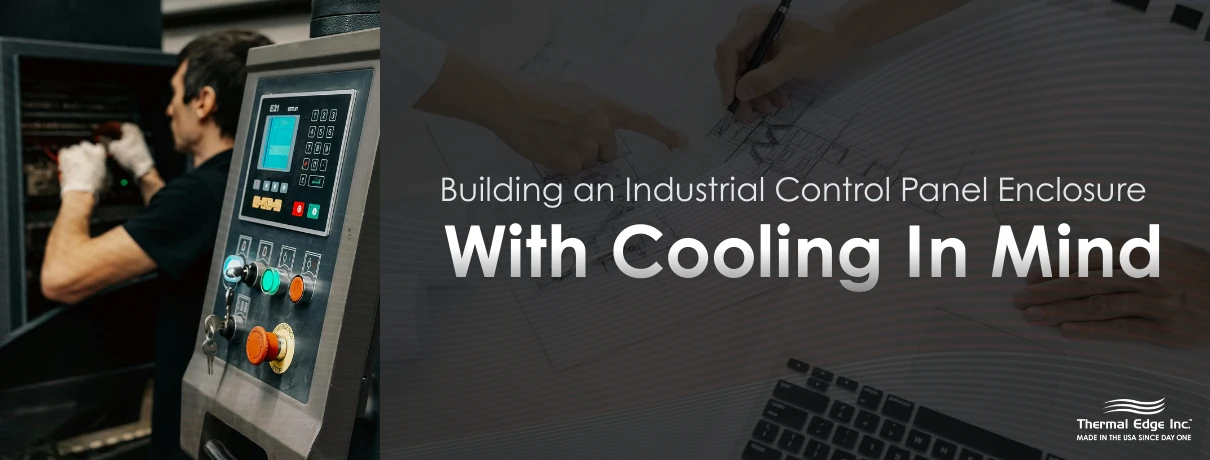Building an Industrial Control Panel Enclosure with Cooling In Mind

Taking proper steps to build an industrial control panel enclosure the right way, with cooling in mind, means the electrical components will last longer, provide trouble free service and be easy to maintain.
Failing to properly plan ahead and making shortcuts to reduce expenses can lead to overheated electrical equipment, unwanted contaminants in the enclosure, and premature component failure. System malfunctions can be very costly in terms of production loss, reliability and safety.
In order to build the best possible industrial control panel, a few important considerations should be made to ensure proper cooling.
Environmental Considerations
The environment in which an industrial control panel is placed can have a significant effect on system operation. In order to build an ideal enclosure the environmental factors must first be evaluated.
If the control panel enclosure is placed in an area where excessive amounts of moisture, dust or contaminants are present, a sealed cabinet with the appropriate NEMA rating must be used. The NEMA ratings are designed to help protect personnel, electrical equipment and valuable property from damage.
Sizing an Industrial Control Panel Enclosure
Choosing the correct control panel size is an important process, since closely packed heat producing electrical components tend to overheat. The control panel should be large enough to provide adequate spacing and allow sufficient air flow between components for proper cooling. Although increased space raises costs, a small enclosure is not always the best choice and may only save money initially, not allowing for future expansion.
Long term maintainability must also be considered. Electrical component access should be easy from all directions for optimal replacement ease. With the cost of downtime being so high, having a maintenance-friendly industrial control panel design is required to keep downtime at a minimum. Once the industrial control panel is installed it’s very difficult to change, therefore getting it right the first time is crucial.
Industrial Control Panels and Heat Load
Besides the importance of knowing the maximum ambient temperature, the amount of heat produced by the electrical components also needs to be established in order to determine which thermal management system will work best. The internal heat load of an electrical enclosure is calculated by adding up all the maximum heat dissipation specifications for every component in the enclosure.
Once a heat load value has been calculated, sourcing a thermal management system with sufficient capacity to properly cool your industrial control panel is a straightforward process when using an enclosure temperature management (ETM) calculator.
Thermal Management Options for Industrial Control Panels
Depending on the amount of heat being generated inside the enclosure, natural ventilation is rarely an option. Once environmental conditions, the required type and size of cabinet and the heat load are known, several thermal management products can be considered for your specific application:
- Filtered fans are inexpensive to operate and ideal for applications with low dust and humidity levels, when the ambient temperature is lower than the desired internal cabinet temperature.
- Air-to-air heat exchangers transfer heat from a sealed cabinet to the outside when the ambient temperature is lower than the desired internal cabinet temperature.
- Air conditioners are ideal for applications where harsh conditions exist consisting of dust, debris or corrosive elements. They will maintain the desired internal cabinet temperature regardless of the ambient temperature.
Industrial control panel cooling requirements can vary considerably. Environmental conditions should be carefully reviewed before choosing the ideal thermal management system.
Keeping Industrial Control Panels Cool
Building an industrial control panel with cooling in mind is a key component to a reliable, trouble free operation. Every installation is unique so every effort should be made to consider all options for your specific application.
A properly built control panel paired with an ideal thermal management system will keep long term operational costs lower since the electrical components inside the control panel will be operating at or below recommended temperature specifications. This will result in enhanced reliability while lowering the risk of premature component failure.
For technical help contact the experts at Thermal Edge and obtain professional advice on building and cooling your industrial control panel.
